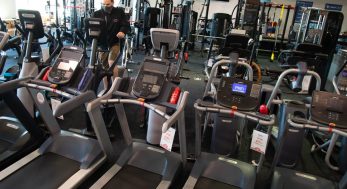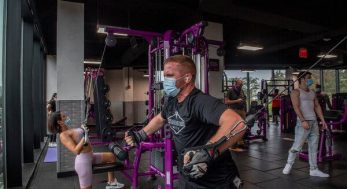Let’s get real: sitting with perfect posture is tough work.
We’re talking about keeping the spine straight, the vertebrae and pelvis stacked on top of each other … keeping your abs slightly squeezed with your shoulders rolled back and down, away from your ears. It’s a lot to think about. Since holding perfect sitting posture requires quite a bit of muscle endurance and mental space, it’s challenging to maintain for 10-15 minutes let alone eight hours.
As the work day progresses, we slip into slouch-mode, over-stressing certain muscles and compromising our shoulder, hip, and back health. You might feel tight, sore, and even foggy after a long desk-bound day. In fact, some studies suggest that sitting for prolonged periods can decrease blood flow to the brain, reducing your mental productivity. What’s more, doctors have found that a sedentary lifestyle can put you at risk for high blood pressure, high blood sugar, and obesity.
The reality is sometimes we can’t avoid sitting for hours. So the key, according to queer certified personal trainer Anna Claire Loper, is to do exercises that counteract the negative effects that come with being on your keister for too long.
“I’m not going to be able to convince my clients to stop sitting,” she says. “I can, however, coach the importance of breathing, and program strength exercises for those under-active and weak muscles — typically, the lats, core, glutes, and hamstrings.”
“Everyone should get into a healthy habit of creating an exercise routine in their workplace,” adds EXOS Performance Specialist and certified trainer Dominique Finkley. “This is proven to boost energy, mental productivity, memory, and creativity while lowering stress levels and anxiety.”
If you’re not sure how to create your own desk routine, no worries. We asked Loper and Finkely what they thought were the most effective exercises you can use throughout your day. For one hour of sitting still, challenge yourself to take a movement break and try one of these out.
Mobility Work
Diaphragm Breathing
Good for: easing muscle tension, nervous system relaxation
How to do it: Put one hand on your chest and one below your ribcage so you can feel your diaphragm move as you breathe. Notice it expand as you inhale for four seconds. Hold for a second, then exhale for four. Repeat five times and check in with your body as you do so. Witness where you are holding tension. “For example, can you ease your shoulders away from your ears?” asks Loper.
Segmented Cat-Cow
Good for: upper and lower back mobility
How to do it: While seated, let your stomach come forward as you extend your lower back one vertebrae at a time, slowly creating a curve in your spine. Lift your chest, then bend your neck back as you look at the ceiling. Next: reverse it. “Tuck the chin first,” says Finkley. “Then start rounding into the upper back, mid-back, and lower back and finish by tucking those hips.” Repeat two to three times.
Figure Four Stretch
Good for: hips, glutes, and lower back mobility
How to do it: From your chair, cross your right ankle over your left thigh. Sit tall and inhale. As you exhale, reach your belly button toward your seat. “Only go as deep into this stretch as you are able to while keeping a long spine,” says Loper. Hold the stretch anywhere from 30 seconds to two minutes then switch legs.
Seated Thoracic Rotation
Good for: neck pain, easier breathing
How to do it: Start with a slight forward lean in your chair. Firmly interlock your hands in front of your chest with a nice firm grip. Inhale. Slowly exhale as you rotate your neck and spine all the way to the right. “Once you can no longer rotate any further, hold that position for a second,” says Finkley. “Then as you lead with your left ear, slowly turn your head over the opposite shoulder.” Return everything back to center and repeat on the opposite side. Do this two to three times per side.
Seated Heart Opener
Good for: chest, upper back, and shoulder mobility
How to do it: If you’re sitting, grab towards the back of the bottom of your chair. If you’re standing — and if your range of motion allows — interlace your fingers behind you near the base of your spine. Lift your chest up towards the ceiling as you pull your shoulders back and down. “Breathe into the chest and belly in this position for three to five deep breaths,” says Loper.
Standing Doorframe QL (Deep Ab Muscle) Stretch
Good for: lower back mobility and IT band tightness
How to do it: Stand in the middle of a doorframe and begin by crossing your left leg over your right. Reach your left arm up and over to grab the doorframe while popping your left hip out. “Exhale to further the stretch and hold for 15 to 20 seconds,” says Finkley. Make sure to repeat on other side.
Fidgeting
Good for: whole body mobility
How to do it: As silly as it may seem, this exercise will help you become more aware of when you sit too long in certain positions. In your chair, “shift your weight from side to side,” says Loper. “If you notice yourself favoring your left hip, shift into your right. If you always cross your left leg over the right, switch it up. [Do] neck circles, ankle circles, wrist circles, wiggle your toes.” Do this for as long as you like and get playful with it!
Wrist CARs (Controlled Articular Rotations)
Good for: wrist and forearm mobility, carpal tunnel
How to do it: Start by grabbing your right forearm with your left hand. Slowly make circles with your right wrist. Make four circles clockwise and then counter clockwise. “There may be some sticky spots,” says Finkley. If so, just work around them and continue the motion. Repeat all of this on the left wrist.
Strength Exercises
When you get back from a long day at work, you’ll want to strengthen the hips and glutes you’ve neglected all day. These are some of the best moves you can do to hit those target areas, according to Finkely. All you need are some resistance bands.
High Plank Hip Flexor Activation
Good for: hip and core strength
How to do it: Grab a light band and place it around the balls of your feet. From there, walk your hands out to a straight-arm plank position. Make sure your wrists, elbows, and shoulders are completely stacked on top of one another. Flex your right foot, then drive the right knee towards your chest. Keep your back flat as you do this. Return your right foot back and repeat on this side for 15 reps total. Then switch to the other side. Attempt two to three sets per side.
Single Leg Abduction
Good for: abductor, glute strength, balance
How to do it: Place a medium resistance band above your knees. From a standing position, drive your hips back as if you’re about to squat. Lean your chest slightly forward and bend your knees until your shoulders are in line with your toes. Lift your left foot up as you begin to stabilize on your right leg. Think about gripping your toes to the soles of your shoes. With your left leg, slowly pull the band away from your midline then come back to neutral. Repeat for 15 reps then switch legs. Aim for two to three sets on each side.
Squat Jacks
Good for: quad, glute and abductor strength
How to do it: Place a heavy resistance band just below your knees. Begin by standing with your feet together then jump your legs out as you drop your hips down and back. Keep your chest high. Come back up into the starting position and repeat this for two to three sets of 15 reps.
This content is created and maintained by a third party, and imported onto this page to help users provide their email addresses. You may be able to find more information about this and similar content at piano.io









